Claudio Ruben Daza Jimenez and his company, VetiverCol, have been working with the Vetiver System for many years and is an important and well proven vetiver business in Colombia. We encourage vetiver based companies to share their work, experience and ideas and suggestions on our website, and we welcome Claudio’s initiative to share his new monthly “VetiverNews” with us that in this edition focuses on “Vetiver and Climate Change”. The original transcript is in Spanish. This post is a Google Translation, plus some editing of that translation. Please note that as a general disclaimer the information data provided by authors may not always represent the views of TVNI.
(Claudio Ruben Daza Jimenez’s newsletter from Colombia – Claudio is CEO Vetivercol Services and Consulting SAS, Ibague, Colombia ([email protected]),Tuesday June 21, 2022. Number 01)
Vetiver and climate change
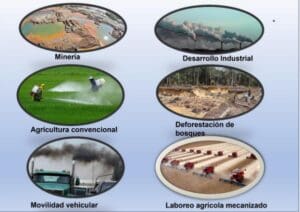
Every day we are concerned about the impact caused by the different types of human behavior on planet earth in the eagerness to achieve industrial development and the transformation of raw materials into finished products without taking account of the consequences; likewise, the use of agricultural inputs of chemical origin and other inputs relating to production affects the air and soil and water in such a way resulting in a marked carbon footprint in nature.
To mitigate some of these problems we need to introduce bioremediation mechanisms to compensate for environmental pollution caused by industrial production, agricultural and commercial development, mobility and even the use of inputs and resources for food subsistence, health and maintenance. Each action leaves a polluting footprint on the environment; effecting all living organisms and we must compensate through mechanisms that free us from the carbon load.
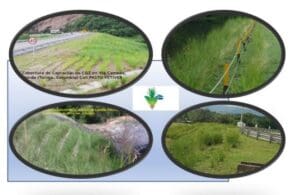
For a long time, greenhouse gases have been captured on land by establishing forests in different countries of the world; however, in Colombia, they have a dual purpose: logging and environmental conservation, in an effort to compensate for the high level of Carbon produced by industries, agricultural, livestock and legal and illegal mining, that fail to comply with the environmental compensatory guidelines.
In Colombia, companies such as Vetivercol Servicios y Consultorias SAS have been planning and executing projects aimed at environmental bioremediation; with successful project application in erosion control; stabilization of slopes, hillsides and riverbanks; and wastewater treatment. The latter is in the form of VETIVER GREEN FILTERS to treat the effluent of the coffee processing, achieving a purification of up to 94% of the contaminated water, enabling the latter to be recycled, for the same process (recirculation of waters).
Companies such as Starbucks Colombia, National Federation of Coffee Growers, Carcafe Ltda, RGC Coffee,
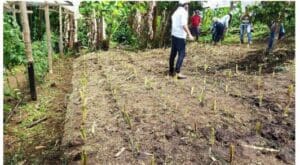
Caravela Coffee, and others seek quality certification in the coffee and in the coffee farms that produce it. Applying vetiver as live barriers for erosion control, and using Green Filters for the treatment of processing effluent discharge from the benefit process of the coffee, contributes to carbon capture and oxygen production, and enhances the company’s reputation as part of their carbon footprint offset with their coffee consuming customers
CARBON SINKS
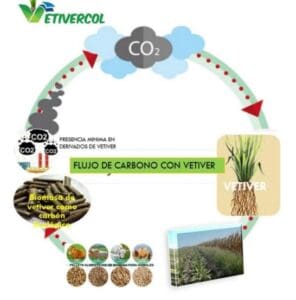
Carbon sinks can be defined as a system or process by which a greenhouse gas or gases are removed from the atmosphere and stored. Currently the concept of carbon sinks in Colombia is for many neither understood nor applied. As knowledge has been developed in the use of the Vetiver System application of different uses of VETIVER has led to its incorporation as a natural bioremediation technology.
VETIVER, a C4 plant of the Gramineae family, is able through phytoextraction of allows it to store in its root system (up to 7 meters in depth), and even more in its aerial foliage, achieving a capture per plant between 5.8 to 6.5 Kg/plant year; which would give as a reference a capture in a planting of 40,000 plants, between 232,000 Kg/ha/year = 232 Ton/ha/year; which is an amount greater than what a hectare of forest captures in trees. (editorial note: there is tremendous variation in carbon capture depending on growing conditions, management and use, and climate – however there is no question that vetiver grass is a highly effective plant for sequestering atmospheric carbon)
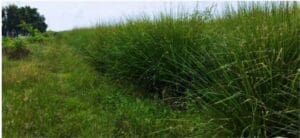
Planting densities of 40,000 VETIVER plants/ha equivalent will provide levels of Vetiver biomass suitable as a biofuel or for animal feed. Vetiver biomass can exceed 140 tons/ha/year and be used as raw material for the production of pellets for animal feed or fuel briquettes for industry or kitchens, and restaurants.
REGULATION OF CO2 SINKS IN COLOMBIA —- LAW 2169 of December 22, 2021
“The transition to carbon neutrality, climate resilience and low-carbon development. The transition towards carbon neutrality, climate resilience and low-carbon development is based on the following pillars”:
- The need to align the actions adopted for climate change with those established for food security , health and poverty
- The fair transition of the labor force that contributes to the transformation of the economy towards sustainable production mechanisms, and that aims at the reconversion of green jobs that provide quality of life and social
- The adoption of measures for the protection of the environmental and socioeconomic environment of present and future
- The implementation of actions of a positive nature, consisting of stopping and reversing the loss of biodiversity and environmental deterioration.
- The co-responsibility of public entities of the national, departmental, municipal and district order, as well as natural and legal persons, public, private and mixed in the definition and implementation of goals and measures in terms of the goals of carbon neutrality, climate resilience and low-carbon development. carbon neutrality, low-carbon development and climate resilience.
- The recognition of the differential characteristics of the economic sectors and the territories in optimizing their contributions to the fulfillment of the national goals in terms of carbon neutrality, low-carbon development and climate resilience. carbon neutrality, low-carbon development and climate resilience.
- Recognition of the fundamental role of an informed citizenry and aware of the impact of their actions on the achievement of the goals of carbon neutrality, climate resilience and low-carbon development
- Recognition of the central role played by women and population groups with special constitutional protection regarding knowledge, the differentiated impact and actions in terms of mitigation and adaptation to climate change.
- The need to define and implement goals and measures for adaptation to climate change and mitigation of greenhouse gas emissions that promote the conservation of biodiversity and water resources, based on the recognition of their intrinsic value and ecosystem they provide.
- The articulation of efforts between the public sector, the private sector and international cooperation, for the financing of climate change management, within the framework of the necessary economic recovery from the crisis generated by COVID-19.
- The importance of promoting an economic transition towards carbon neutrality that promotes the strengthening of the productive apparatus and its competitiveness in national and international markets.
- The recognition and guarantee of human rights within the national climate action, for the reduction of inequities, inequalities due to the differentiated effects of climate change.
- The importance of continuing to establish goals, measures and actions that allow progress in meeting the Sustainable Development Goals-SDG.
- The need to create strategies for the protection of jungles and forests; of the national territory, end deforestation, and recognize the importance of establishing measures of sustainability and responsible use of natural resources to achieve the objectives of carbon neutrality, climate resilience and low-carbon development.
- Recognition of the fundamental role that young people have in society as subjects in need of training in actions to protect the environment in order to achieve the goals of carbon neutrality, climate resilience and low-carbon development.
- The need to define and implement goals in education for the new generations in strategies and actions for the mitigation of climate change, conservation of biodiversity and care of water resources.
(Source: chrome- LAW No. 2169 of December 22, 2021, issued by the CONGRESS OF COLOMBIA)
THE CLIMATE ACTION PROJECT LAW, seeks to create minimum measures in the short, medium and long term that will allow the country to achieve carbon neutrality by 2050; that is, that Colombia can offset its emissions of Greenhouse Gases (GHG). Likewise, by 2030 it proposes: • Reduce deforestation to zero.
Based on LAW No. 2169 – Presidency of the Republic
ZERO NET EMISSIONS.
According to the United Nations, the goal is to ensure that large companies achieve the minimum emission of Greenhouse Gases, in order to reduce Global Warming and compensation is sought with the oceans and forests. Net Zero Coalition | Naciones Unidas
Carbon capture by trees is not as fast as capture by grasses. Vetiver grass (Chrysopogon zizanioides) can capture per cultivated plant from 5 to 6.5 kilograms per year, starting capture at 90 days after planting, and with a planting density of 40,000 plants per hectare, a carbon capture of 200 to 260 tons/ hectare/year is possible; and maybe a faster alternative than the establishment of forests, at a lower cost, and with an advantage in the Vetiver biomass, since it can be processed into animal feed, or biofuel.
Implementation of Carbon capture sinks using vetiver, could help reduce global warming faster and at a much lower cost; achieve multi-purpose benefits development of green businesses and establishment of Green Bonds that finance the development and maintenance of vetiver based projects.
How much of the carbon remains as long term SOC? The data that I have seen is hugely variable. However vetiver does appear to be a superior plant for carbon capture and its starts doing this quickly . Do you have any recent data from India?
Our studies in India showed that could sequester around 13 t C/ha/year.